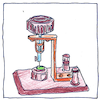Reginald Fessenden
electromagnetism

|
Electrolytic detector
Radio receivers from 1903 until 1913 used Reginald Fessenden’s bare-point electrolytic detector to convert radio waves to pulsed direct-current signals capable of receiving either Morse code or AM signals.
How it works
A fine platinum wire immersed in an electrolyte solution acts as a rectifier for a small oscillating charge. When the oscillation gives the tip a positive charge, electrolysis of the electrolyte produces bubbles that cling to the wire to prevent current from flowing. When the oscillation gives the tip a negative charge, current flows across the electrolyte.
Not to put too fine a point on it
You mean exactly what you say about it.



Other people such as Michael I. Pupin, W. Schloemilch, and Hugo Gernsback have also been given credit for the discovery of this device; however, Reginald Fessenden, who was also responsible for the development of AM radio, was the first to put it to use. The electrolytic detector was sometimes called the Schlömilch cell, the Ferrié cell, or the Fessenden cell.
See also in The book of science:
Readings in wikipedia:
Other readings: